
Extrication Tips: January 2011
Randy Schmitz
Features Extrication TrainingSide-impact crashes account for almost 30 per cent of collisions in North America and are the second-leading cause of death and injury to vehicle occupants. More than 10,000 people on North American roadways are killed annually from these types of crashes (1,000 in Canada; 9,000 in the United States).
Side-impact crashes account for almost 30 per cent of collisions in North America and are the second-leading cause of death and injury to vehicle occupants. More than 10,000 people on North American roadways are killed annually from these types of crashes (1,000 in Canada; 9,000 in the United States).
When a vehicle crashes into the side of another vehicle, even at speeds as low as 35 kilometres per hour, the result is often head trauma or death of the driver or passenger(s) in the vehicle that was struck.
A number of factors can contribute to a passenger’s condition after being involved in a crash, including:
- vehicle mass and type
- drivers and passengers who are not wearing seatbelts
- size and age of the occupants
- seating position of the occupants in the vehicle
- speed of the vehicles prior to impact
All these factors increase the risk of death or of serious injury after being involved in a collision. Therefore, the Canadian and U.S. governments mandate that all new vehicles be equipped with side-impact protection. This is generally accomplished by adding a high-strength metal beam, extra foam padding inside the door and supplemental airbag protection such as roof curtain airbags, torso airbags or side-impact inflatable devices.
The Insurance Institute for Highway Safety and the National Highway Traffic Safety Association continue to test for head protection in side-impact crashes. In 2003, these organizations released a study showing that head protection systems reduced driver and passenger fatalities by 45 per cent. Side-impact protection provides protection against the window glass or frame or an impacting vehicle, pole or tree.
Most roof curtain or head protection systems have an additional benefit: because they remain inflated longer than frontal airbags and typically cover the full window area, they can prevent passengers, unbelted or belted, from partial or full ejection through the side windows during a rollover collision.
Torso airbags usually inflate from the seat back, while head protection systems usually inflate from the roof. Systems that combine head and torso protection usually inflate from the door or the seat.
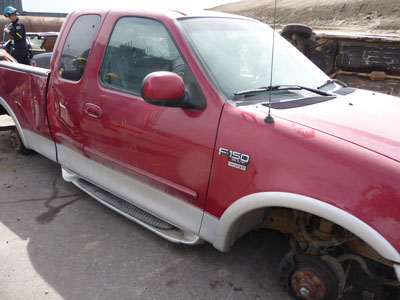 |
|
| Photo1: Extended cab door opens only to 90 degrees. | |
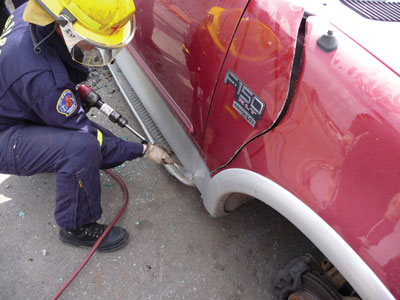 |
|
| Photo 2: Spread the hinges of the vehicle body. | |
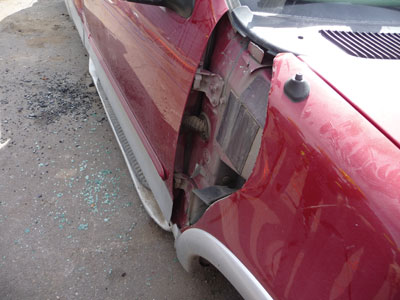 |
|
| Photo 3: Cut the hinges with hydraulic cutters, a reciprocating saw or an air chisel. | |
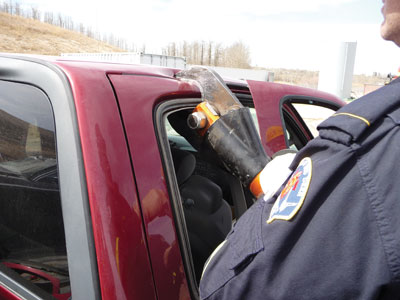 |
|
| Photo 4: The top latching mechanism of the door near the roof rail will need to be cut. | |
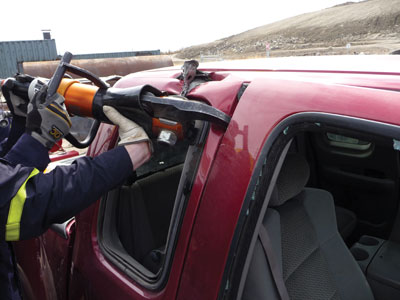 |
|
| Photo 5: If access to the latch has not opened up, cut the door frame and roof rail. | |
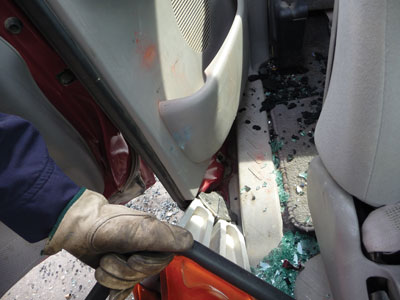 |
|
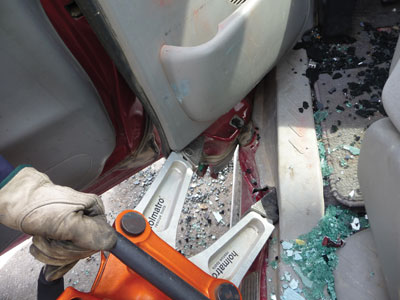 |
|
| Photos 6 and 7: Spreading the door away may cause the rocker to give way before the latch. | |
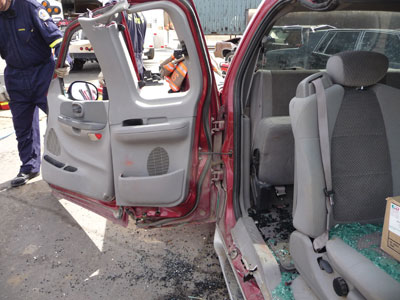 |
|
| Photo 8: Once the last cut is made, the front and rear door assembly is ready to be opened up via the rear hinges.
|
Extended-cab pickup trucks
Extended-cab pickups have become very popular in recent years as they have extra space behind the main seat. Originally, extended-cab trucks used side-facing jump seats that could fold into the walls, but newer models have full benches in the back. Extended cabs are available with either full doors or narrow, rear-hinged back doors. While these half-doors may work fine in the showroom, they tend to be cumbersome in tight spaces because most of them open only to about 90 degrees (see photo 1).
The handles for these rear doors are located along the edge, not on the outside like on a regular door. The handle is not visible and cannot be accessed unless the front door is opened first. Rescuers should be aware of an important design mechanism: the rear doors have two Nader-style latches at the top of the roof rail and at the bottom of the rocker panel to keep the door closed, plus another latching mechanism that locks the handle to the front door.
Suicide doors
Some of you may remember suicide doors, a term given to the doors on smaller cars that were similar to the rear doors on extended-cab pickup trucks and opened outward on rear hinges. Some sources say that the name stems from a weakness inherent to the body design; in a heavy, rear-end collision, the lead vehicle has a tendency to fold up (accordion-like) at its weakest point. The weakest point was assumed to be at the leading edges of the suicide doors, just in front of occupants, instead of behind the occupant, as is the case with conventional doors. Very little structure was required to support the doors and hinges, and there was no B-pillar as part of the vehicle body, so the doors were susceptible to being crushed. Today’s vehicles that have the same conceptual design are the Honda Element, Toyota Cruiser, Mazda RX-8 and Mini Clubman. However, manufacturers have improved the design by reinforcing the doors; this modification keeps the doors closed in a crash and the doors now withstand greater collision forces. But, like the older vehicles, newer vehicles are still designed without a B-pillar.
Although these new vehicles fare well in side-impact crashes, there is a point at which a crash can be severe enough to cause intrusion to the passenger space, trapping and injuring occupants. Great care must be taken in these situations to avoid aggravating suspected injuries.
Often, rescuers’ approach to a typical side-impact crash is to create a purchase point on the latch side of the front door, near the handle, to try to access the door latch and roll it off the Nader pin. This can be done effectively in a number of cases. In a vehicle with rearward opening doors and no B-pillar, the only way to access rear-seated passengers is to open the front door first to allow access to the handle on the rear door. The “latch attack” with hydraulic spreaders is very likely to aggravate injuries to occupants, because the lack of a B-pillar means the structural integrity of the vehicle is less reliable.
A front-door hinge attack is an option that will reduce the injury aggravation of patients and create a large opening for egress. In this option, the side opening procedure is farther away from the victim and moves the door(s) away from the victim’s injuries. Depending on your equipment, you can spread the hinges of the vehicle body and cut them with hydraulic cutters, a reciprocating saw or an air chisel (see photos 2 and 3).
Don’t forget about unbolting hinges. The top latching mechanism of the door near the roof rail will need to be cut away to disconnect the top of the door assemblies from the vehicle body. This cut can be done from the outside at a 90-degree angle to the door frame (see photo 4).
If access to the latch has not opened up or is not possible, simply cut the door frame and roof rail at the top as depicted in photo 5.
Another cut to the frame will be required, adjacent to the first cut, to completely sever and disconnect the latching mechanism and separate it from the upper door frame. Always look beneath the trim or head liner material to expose any potential roof curtain cylinders before cutting in this area. Seatbelt pretensioners are often part of the seat and should not cause any problems. The use of hard protection between tools and patients is a must.
The next step is to insert the spreader tips between the front edge of the door and the vehicle body to start the space-making process. This allows rescuers to gain better access to the bottom latch mechanism that locks the lower half of the rear door to the rocker panel. Be aware that spreading the door away in this area may cause the rocker to give way or to tear before the latch breaks (see photos 6 and 7).
If space permits, insert a hydraulic cutter and sever the latch and any torn sheet metal. Once this last cut is made, the whole front and rear door assembly is ready to be opened up via the rear hinges – just like a gate – to give complete access to front and rear passengers (see photo 8).
The benefit to this procedure is that patient spinal manipulation is reduced, as the patient can be brought out of the vehicle at a reduced angle, rather than a 90-degree turn onto a back board.
A rearward attempt, starting from the rear door hinges, is discouraged. The hinges are often hidden deep within the vehicle body, making access difficult. Spreading the shorter rear door from the rear hinge side becomes difficult, as resistance to the door bending and folding down and away is significantly increased. This may cause further aggravation to injuries, and the tools used will generally be very close to the rear-seated victim.
This simple but effective procedure may not always be ideal; however, it will allow for a systematic approach to vehicles that are equipped with suicide doors, like the ones we are seeing again on our roadways.
Randy Schmitz is a Calgary firefighter who has been extensively involved in the extrication field for 18 years. He is an extrication instructor and has competed internationally. He is the education chair for Transport Emergency Rescue Committee (T.E.R.C.) in Canada, a T.E.R.C. International extrication judge and a tester and evaluator for manufactured prototype products for extrication equipment. He can be reached at rwschmitz@shaw.ca.
Print this page